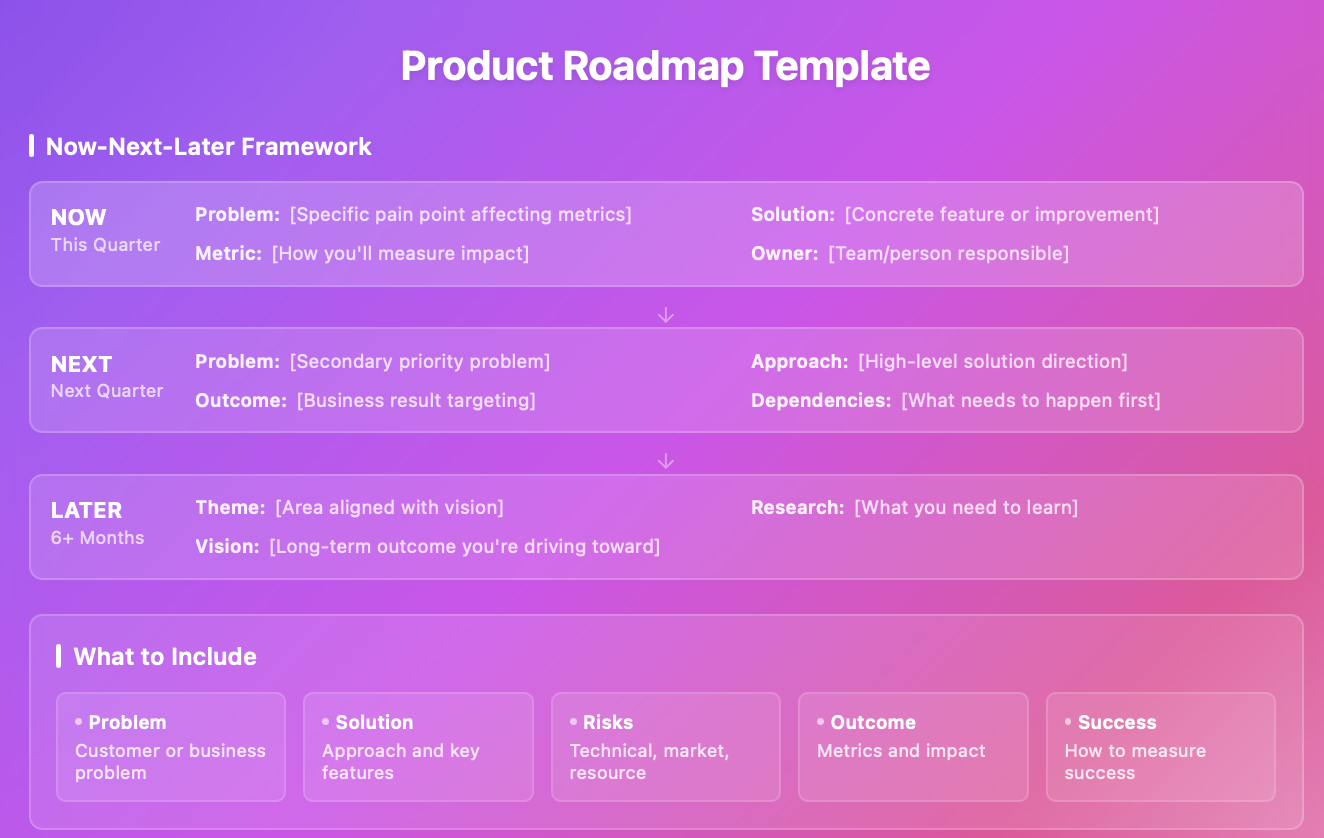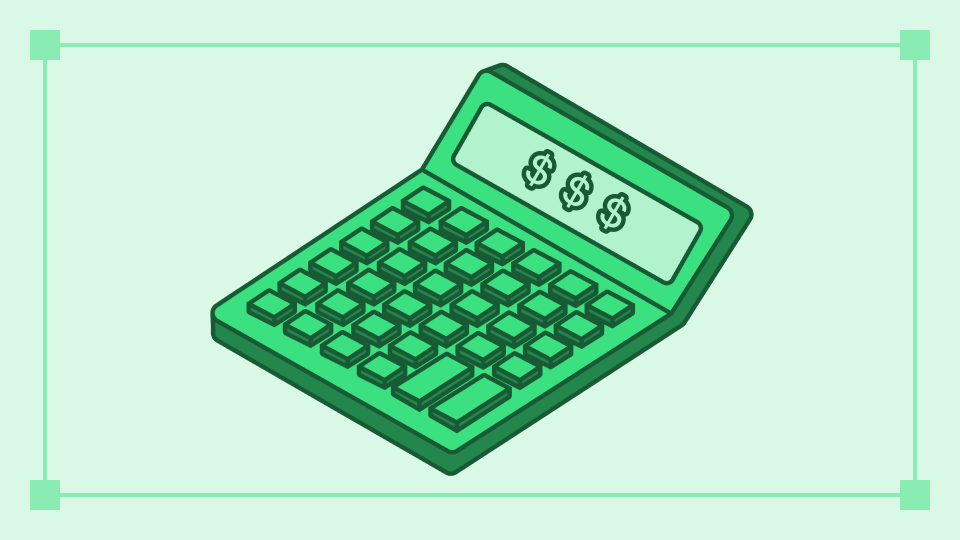Product roadmap
What is a product roadmap?
A product roadmap is a content asset (document, video, PDF, blog, etc.) that shows the vision, direction, and priorities for a product or features over time. It communicates what you're building, why you're building it, and roughly when it will be available. Today, most teams build quarterly product roadmaps.
Key characteristics:
- Strategic communication tool, not a project plan with deadlines
- Focuses on outcomes and customer problems, not just features
- Changes based on data and market conditions to retain more customers
- Aligns teams around shared priorities and business goals
However, most roadmaps become beautiful documents that teams ignore within weeks. You spend endless hours aligning stakeholders on a 12-month plan, only to watch market conditions change everything by month two.
Are you building roadmaps that nobody follows?
Every product team faces the same exhausting cycle:
- Quarter 1: Leadership demands a detailed annual roadmap. Teams scramble to estimate timelines for features they haven't designed yet. Stakeholders debate priorities in conference rooms while customers wait for basic problems to be solved.
- Quarter 2: Market conditions shift. Customer feedback reveals the roadmap missed critical pain points. Engineering discovers technical complexities nobody anticipated. The roadmap becomes outdated fiction.
- Quarter 3: Teams quietly abandon the original plan. New priorities emerge from customer complaints, competitive threats, or executive whims. Nobody updates the roadmap document because it's too painful to admit how wrong the predictions were.
- Quarter 4: Planning season starts again. Teams repeat the same process, hoping this time will be different.
This happens because we're building roadmaps for a predictable world that doesn't exist.
Product roadmap vs. product backlog vs. project plan
Here's the difference between the three things teams constantly confuse:
- Product roadmap: Strategic direction and priorities over time. Focuses on outcomes and themes, not specific features or dates.
- Product backlog: Tactical list of features, user stories, and improvements ranked by priority. Changes frequently based on the roadmap direction.
- Project plan: Execution timeline with specific tasks, dependencies, and deadlines. Used for coordinating development work.
Teams get stuck when they try to make roadmaps do the job of backlogs or project plans.
Roadmaps should also answer "why" and "what," not just "exactly when" and "how."
Building vision-driven product roadmaps that work
Start with a clear product vision. A strong roadmap begins with a product vision that acts as a compass, defining the desired future state and impact your product aims to create.
This vision filters potential paths and prioritizes initiatives that truly matter, preventing your product from becoming a "feature factory" - a collection of features without strategic direction.
Balance three investment horizons:
- Short-term bets (0-3 months): High-confidence opportunities for immediate impact, like optimizing existing features, A/B testing improvements, and customer-driven fixes
- Medium-term extensions (3-12 months): Expanding to new user segments, adjacent features, and integrations that increase engagement
- Long-term investments (12+ months): High-risk, high-reward projects like new product categories or major platform shifts
Then focus on outcomes, not features. State goals like "reduce customer churn by 15%" instead of "launch retention feature by Q3." This encourages learning and evidence-based decision-making rather than just shipping features on schedule.
The dynamic approach for building product roadmaps
Use the Now-Next-Later framework. Focus on periods of intention rather than specific dates:
- Now: What you're building this quarter with high confidence
- Next: What you plan to tackle in the following quarter
- Later: Strategic direction beyond six months
 Image source: Optimizely
Image source: Optimizely
This breaks work into manageable chunks and allows easier reorganization each quarter without starting over completely.
- Build in experimentation: Use feature flags and A/B testing to validate roadmap assumptions before committing full development resources. Optimizely's Feature Flagging lets teams test roadmap bets incrementally, reducing risk and improving outcomes.
- Adapt based on learning: Good roadmaps incorporate change, allowing flexible details that enable teams to adapt based on new information. Plans should flex based on customer feedback, market conditions, and technical discoveries.
Product roadmap communication: Different audiences, different needs
For leadership and executives:
- Focus on business problems and opportunities
- Highlight dependencies and resource requirements
- Connect roadmap initiatives to company goals and revenue impact
For field teams (sales, customer success):
- Emphasize tangible deliverables and customer-facing improvements
- Clarify what problems are NOT being solved to manage expectations
- Provide realistic timelines for customer communications
For customers:
- Share new capabilities and major feature releases
- Offer high-level timelines without specific dates
- Include safe harbor disclaimers acknowledging that plans may change
For product and engineering teams:
- Detail your technical approach and architecture decisions
- Show how initiatives connect to the overall product strategy
- Include success metrics and validation approaches
A 2025-2026 product roadmap example
Here's how our team is handling product roadmap in 2025 for this year and 2026.
Instead of annual planning documents, they run quarterly "streaming roadmap" series. Product leaders share what's coming in an on-demand video format that fits busy schedules.
Optimizely's Summer '25 series shows this approach, where product leaders share upcoming capabilities across AI, Analytics, Testing, Personalization, Content, and Commerce in an on-demand video format.
Key elements that work:
- Transparent communication with customers about upcoming features
- Safe harbor disclaimers acknowledging that plans may change
- Regular updates rather than big annual reveals
- Focus on the capabilities teams will use soon
This approach acknowledges roadmaps as conversations, not contracts. Teams stay honest about uncertainty while providing valuable strategic direction.
Roadmapping pitfalls that kill products
- The feature factory trap: Teams measure success by shipping features rather than solving customer problems. Roadmaps become endless lists of capabilities nobody asked for.
- Planning theater: Spending weeks building detailed roadmaps that look impressive in presentations but provide no real strategic value. Beautiful documents that nobody follows.
- Stakeholder whiplash: Changing roadmap priorities every time someone important has a new idea. Teams lose focus, and customers get confused by inconsistent product direction.
- Communication breakdowns: Not explaining why roadmap priorities change. Teams lose trust when plans shift without clear reasoning about customer needs or market conditions.
- Deadline obsession: Treating roadmap timelines as commitments rather than estimates. Creates pressure to ship mediocre features on schedule instead of great solutions when they're ready.
Measuring product roadmap success: Key performance indicators (KPIs)
Four things to keep in mind:
1. Business impact metrics
- Revenue influence: Track how shipped features affect customer lifetime value and expansion
- Customer satisfaction scores: Monitor NPS and CSAT changes after roadmap deliveries
- Time-to-value: Measure how quickly customers realize benefits from new capabilities
- Market share growth: Connect and deliver product improvements
2. Operational efficiency indicators
- Team alignment scores: Survey teams about roadmap clarity and strategic direction
- Decision velocity: Time from roadmap priority to development start
- Feature adoption rates: Percentage of customers using new capabilities within 90 days
- Roadmap accuracy: How often do timeline estimates match actual delivery
3. Platform-driven measurement
Product analytics provide real-time visibility into roadmap impact. Teams can connect product improvements to business outcomes without waiting for quarterly reports.
4. Communication effectiveness
- Stakeholder understanding: Can teams explain why features are prioritized?
- Customer feedback alignment: Are roadmap priorities solving problems customers actually report?
- Cross-functional coordination: How well do product, marketing, and sales teams collaborate on roadmap execution?
Getting started (Without the planning theater)
Three takeaways:
- Map customer problems to revenue impact: Use customer journey analytics and support data to identify pain points affecting business metrics. Build roadmaps around solving these first.
- Implement experimentation-driven validation: Test roadmap assumptions with feature flags and experimentation before committing resources. This approach reduces development risk and improves feature success rates.
- Choose one framework consistently: Pick Now-Next-Later, theme-based, or OKR-driven approaches based on team needs. Framework consistency improves team alignment and decision speed.
Don't spend months building perfect roadmaps. Start with quarterly priorities based on customer data, then improve your process based on what you learn.
The best roadmaps are the ones teams actually follow and update based on real feedback.

